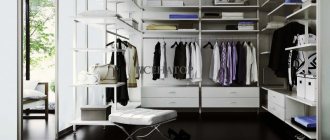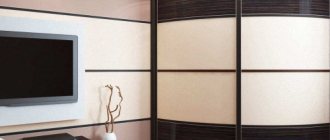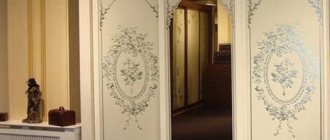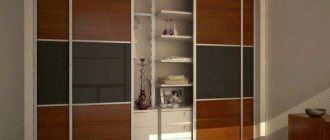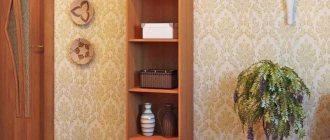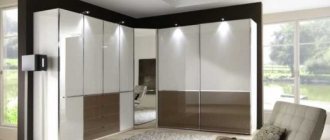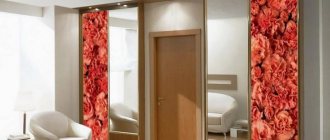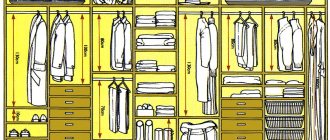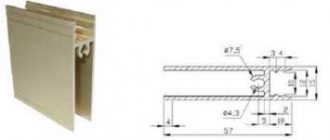Hello fashionable radius!
Radius cabinets got their name, first of all, because all furniture surfaces (facades, doors, shelves) have a curved shape, which gives it soft features. In this regard, such structures are also called radial.
Such furniture is distinguished by a number of unique qualities and advantages that significantly influence their competitiveness.
Among them are factors such as:
- saving apartment space;
- the possibility of their installation in apartments (premises) with a complex layout (geometry);
- the absence of sharp corners on them, which reduces the risk of domestic injuries;
- original methods of execution and design of cabinets.
Therefore, it is not at all surprising that today such cabinets are at the peak of popularity.
Although they still have less capacity compared to standard (rectangular) options, their price is definitely higher, and they need to be made mainly to order.
Photos of radius cabinets
Read here! Corner cabinet - tips for choosing, placement nuances, installation options and the best models of 2021
Please repost
0
1
Meeting hosts and guests
An excellent solution in terms of aesthetic improvement of an apartment can be radius cabinets in the hallway.
Living spaces furnished with such products immediately look impressive and fashionable. After all, the curved lines of the radius cabinet in the hallway immediately attract the attention of guests and serve as a sign of the well-being of the apartment owners.
The curved shape of the cabinet in the hallway allows for optimal use of the available space: in narrow areas the depth of the product decreases, in freer areas it becomes larger.
This form of products allows you to occupy any complex configuration of the hallway. Unlike straight forms, there are simply no such restrictions for radius furniture. The radial lines of the facade give a beautiful appearance.
Meanwhile, among the problems that accompany the decision in favor of this furniture, one should note lower capacity and limitations in materials.
For example, you cannot place a mirror on the facade, since the image of a person there will simply be a caricature.
Special class
Of course, radius sliding wardrobes are included in a special class of radial furniture. Their difference from ordinary coupes is their curved shape. However, it is precisely this circumstance that creates a number of difficulties.
The main elements of the radius system are a curved guide, rollers (bearings), and stoppers that allow you to fix the blade in the required direction.
Moreover, radial coupes use bottom-mounted and top-mounted mechanisms.
In the hanging version, the guide is attached to the top of the cabinet, or to the ceiling. It is noteworthy that in this case the lower part is missing.
The movement of the cabinet doors is ensured by special plastic bearings, which are installed at the bottom of the doors and make the movement of the cabinet door elements silent.
In turn, the bottom-support sliding mechanisms are attached to the floor or to the bottom of the body, and the doors are opened by means of rollers that move along a curved guide rail.
In this case, rollers are installed at the top of the cabinet to secure the facade in the opening and to prevent the door from falling when opening.
Varieties
Radial cabinets differ in the shape of the corner in which they are mounted. Products are also classified according to the type of external surface that faces the room. Basic options will suit most interiors. But owners of non-standard premises will have to order furniture individually.
Types of cabinets according to the shape of the corners:
- 90 degrees is the simplest design. It is mounted in a regular right angle, that is, it will suit almost any room. The closet is spacious and takes up little space. Due to various design solutions it can visually enlarge or reduce the room. The design is usually symmetrical.
- Offset - asymmetrical model. The part located along one wall is larger than the second. Suitable for narrow long rooms. Uses corners where another structure would not fit - for example, the corner next to the front door, where it is impossible to place a cabinet with hinged doors. Externally, it conceals the difference between the lengths of the walls and balances the room.
- Beveled - such a corner wardrobe expands or narrows from the center to the edge. The design can be narrow in the corner (filled with decorative elements) and wide at the edges (more space for storing small items: clothes, dishes, shoes). The opposite option - the closet narrows towards the edges, making its contents more accessible, but at the same time it expands towards the center, creating volume for storing large items (household appliances, boxes of out-of-season shoes and clothes).
- An unfolded cabinet is a model with a relatively small door. It’s convenient to distribute things inside - put away those that are not needed every day against the wall, and put closer those that are needed often. Suitable for rooms not encumbered with furniture, as a means of storing everything at once.
Criteria for choosing white corner cabinets: styles, materials, shades, shapes
90 degrees
Displaced
Beveled
Selecting a cabinet based on design features is the first stage. The next thing to think about is the appearance of the furniture. Based on the shape of the surface, the following types of cabinets can be distinguished:
- Convex. The radius of curvature faces outward. Suitable for large rooms where such a structure can be freely placed. It takes up a lot of space in a small room, but it will look organic in a large one.
- Concave. The cabinet doors are curved inward. Suitable for small rooms - firstly, it frees up space, and secondly, mirrors will help visually expand the space. It is also useful in large rooms if it is consistent with the rest of the interior.
- Wavy. This cabinet combines concave and convex parts. Technically, these models are the most difficult to assemble (the façade elements must be positioned so that the doors easily slide across the space allocated for them). Furniture requires a lot of space along the walls. Suitable for rooms of different sizes with a stylish interior.
There are also separate semicircular radius wardrobes, corner and ordinary. They occupy not only a corner, but also part of the wall; their shape resembles an even semicircle. These designs look good in high-tech rooms, but require a lot of space.
The ideal option for a small room is a cabinet with a concave surface, located at 90 degrees, or offset if the room is narrow.
Convex
Concave
wavy
Semicircular
To order
Another important feature is the fact that, given the numerous features (in terms of price), today radius cabinets are mainly made to order.
This approach to work allows the buyer to receive exactly the product that he originally wanted.
In particular, carrying out work to order involves calling a craftsman to your home, who will be able to clarify all the details of the project on the spot and obtain the measurements necessary to create a radius cabinet (primarily, taking into account the features of curved structures).
At the same time, a person who wants to get a radius cabinet must first decide for himself on the type, shape and features of the radial product (material, guides and all that).
Decide on the project budget and choose a contractor who is known to provide, first of all, quality products.
And then soon an excellent radius wardrobe will appear in the buyer’s apartment, which will give it new charm and charm.

